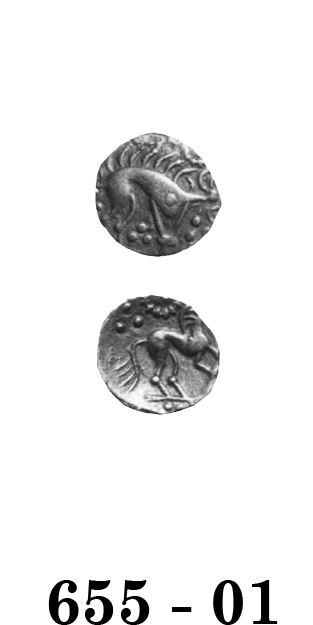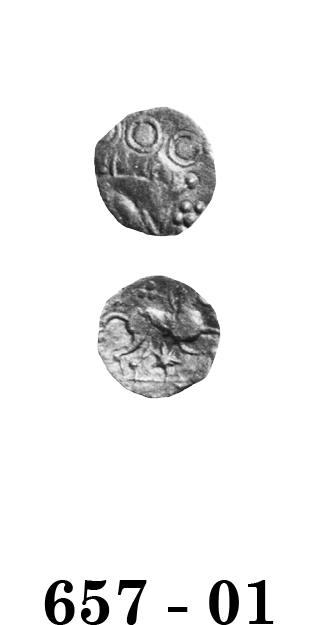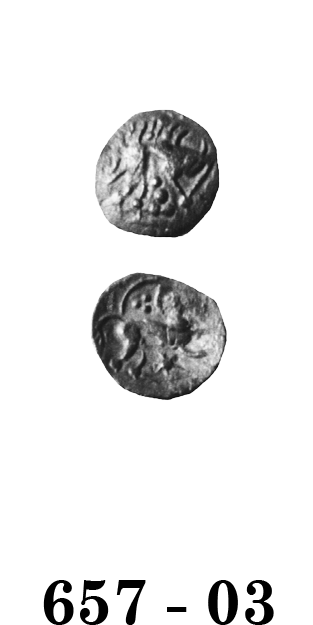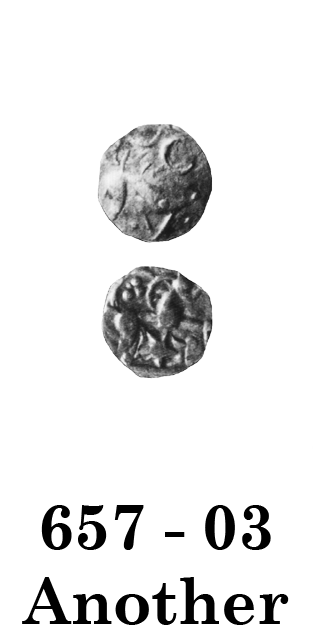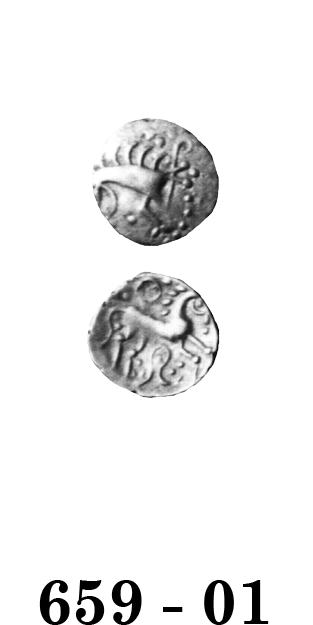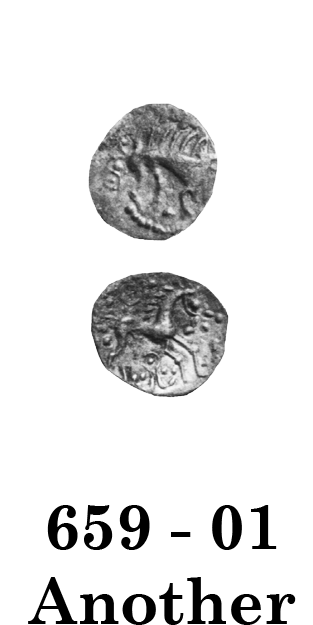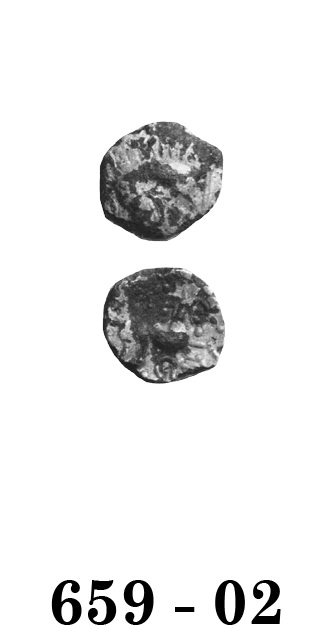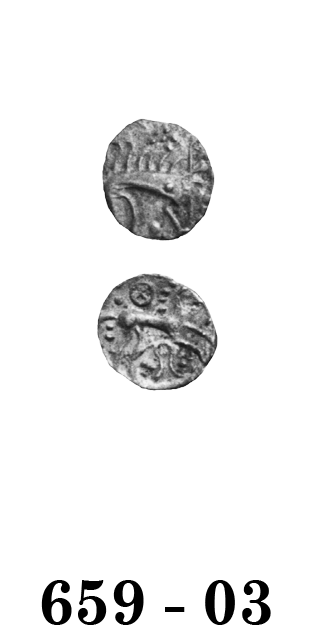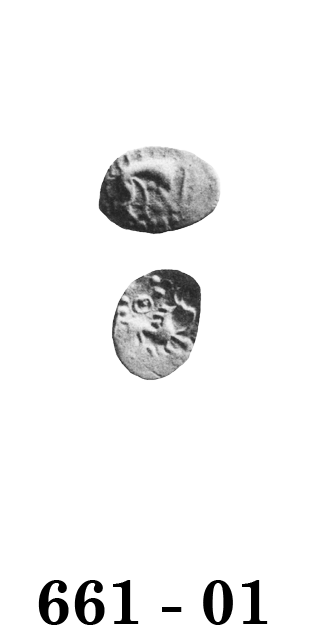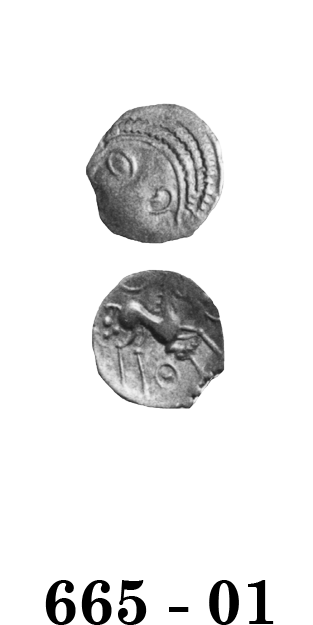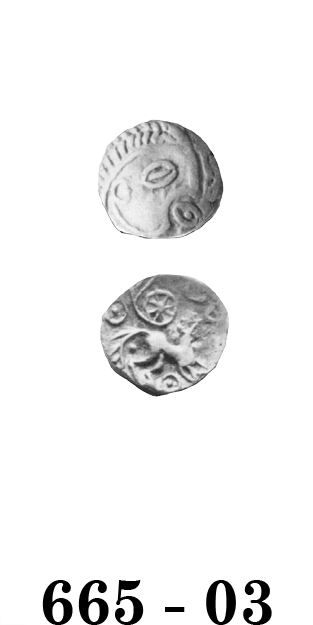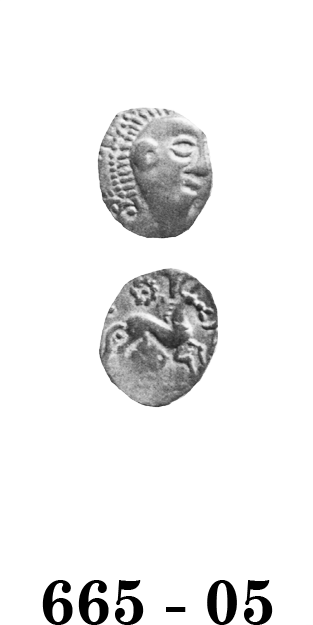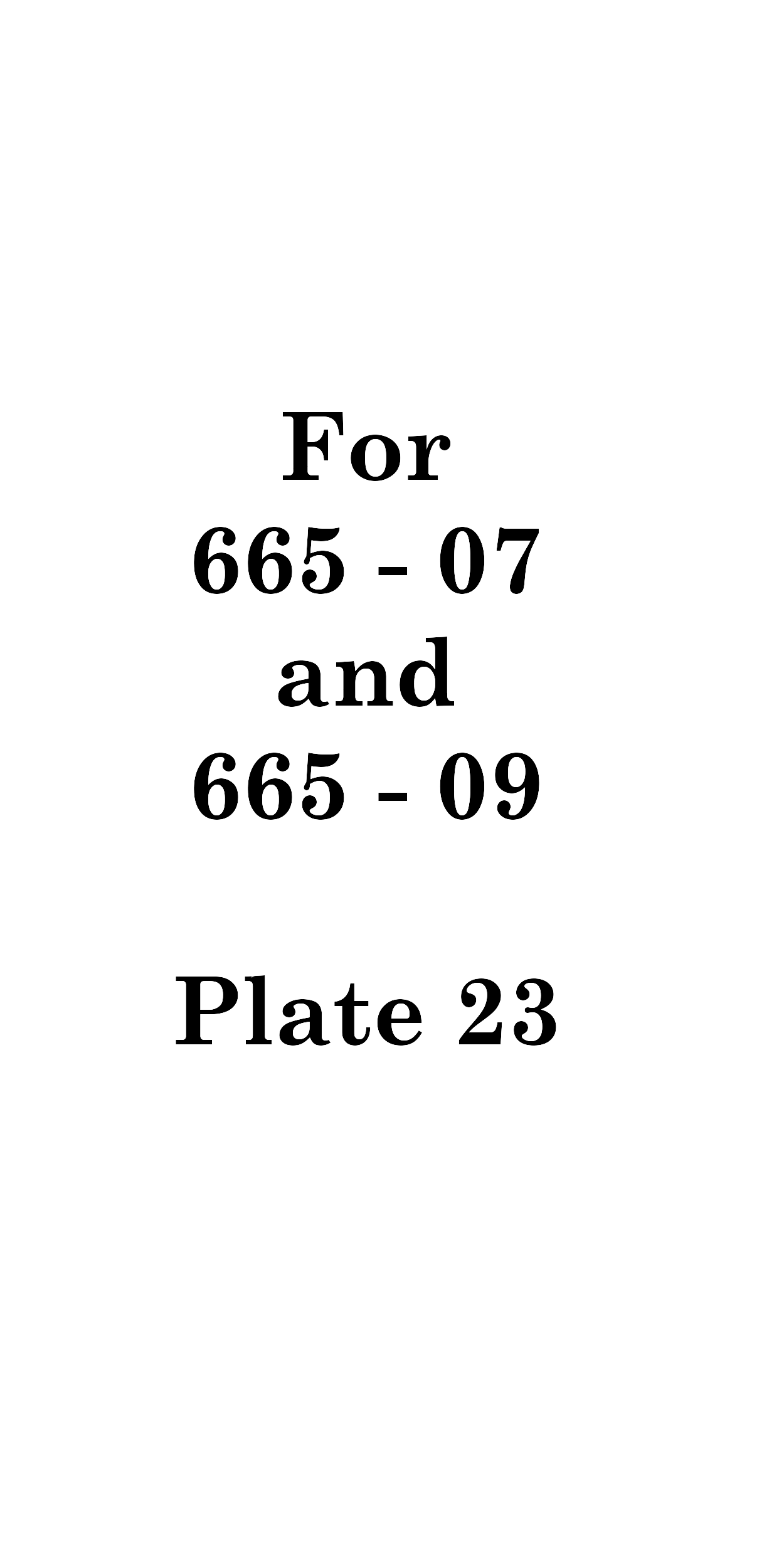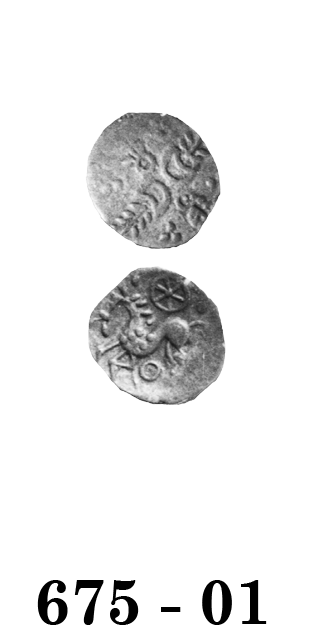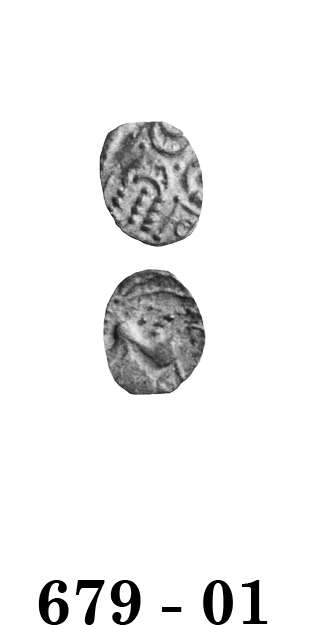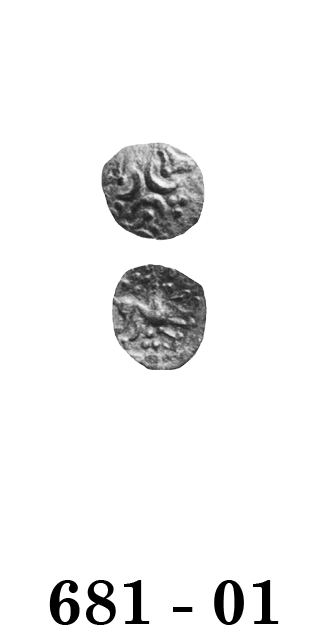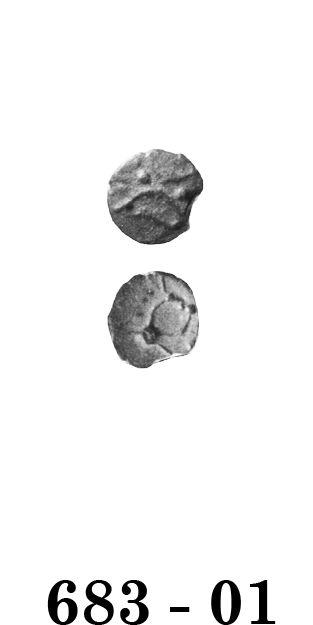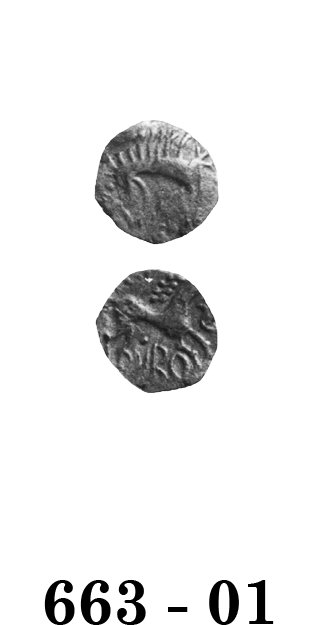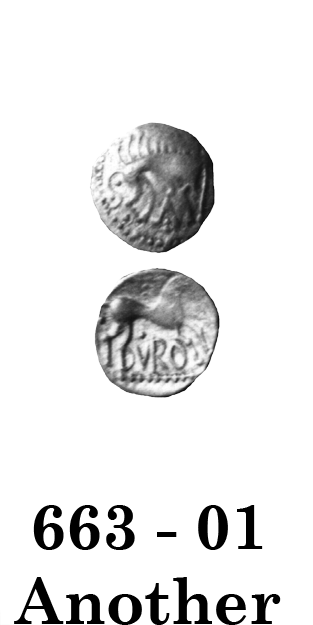
Celtic Coinage of Britain
third edition
Click on coin to see hidden information
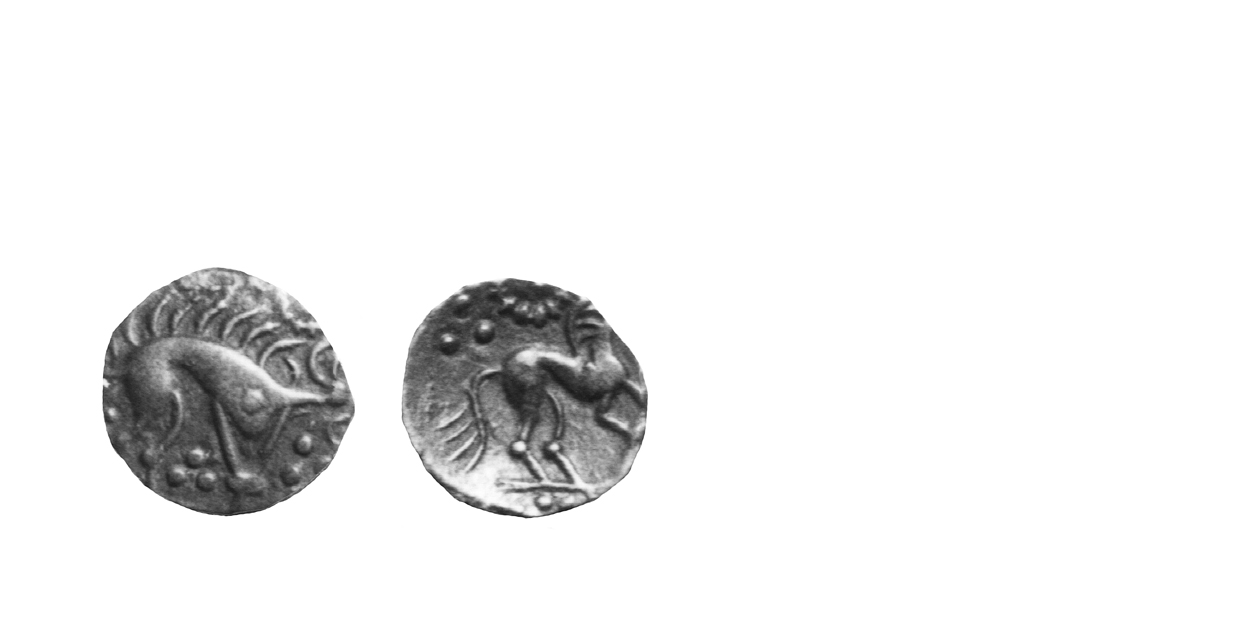
655 - 01 Boar Type
15 B.C. - 20 A.D. Rare
Silver Unit ca. 1.0 gm. 13 mm
Earliest Record: Evans, 1864
OBV: Boar right
Identifying points:
1) ring of pellets above boar
2) three pellets below boar
3) upper portion of boar's front leg comprised of two lines
4) pellet on boar's shoulder
REV: Celticized horse right
Identifying points:
1) ring of pellets above horse
2) three pellets above horse
3) horse stands on exergual line with pellets below
4) horse's tail made up of a single line with shorter lines coming off at an angle
CLASSIFICATlON: Icenian C
NOTES:
– Celtic Coin Index records indicate coin is commoner than previously thought, as anticipated in previous edition of Celtic Coinage of Britain
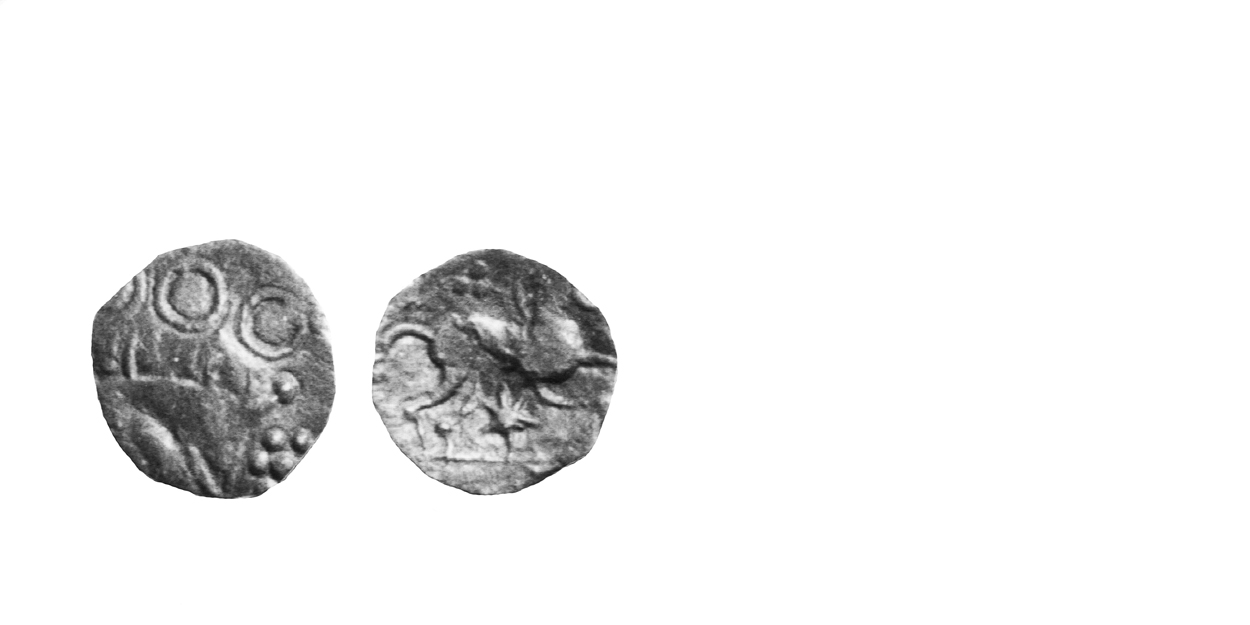
657 - 01 Boar Type
15 B.C. - 20 A.D. Common
Silver Unit ca. 1.1 gms. 14 mm
Earliest Record: Evans, 1864
OBV: Boar right
Identifying points:
1) pellets in front of boar, possibly in a ring
2) four pellets below boar
3) upper portion of boar's front leg comprised of two lines
4) no pellet on boar's shoulder
5) boar stands on a double exergual line with a row of pellets between the two lines
REV: Celticized horse right
Identifying points:
1) three pellets and large crescent above horse
2) six-pointed star below horse
3) horse has 'necklace' and 'belt'
4) horse's tail made up of a single line with shorter lines coming off at an angle
5) horse has eye comprised of a large pellet
CLASSIFICATION: Icenian C
NOTES:
- Celtic Coin Index records indicate coin is commoner than previously thought, as anticipated in previous edition of Celtic Coinage of Britain
- Many are in museums
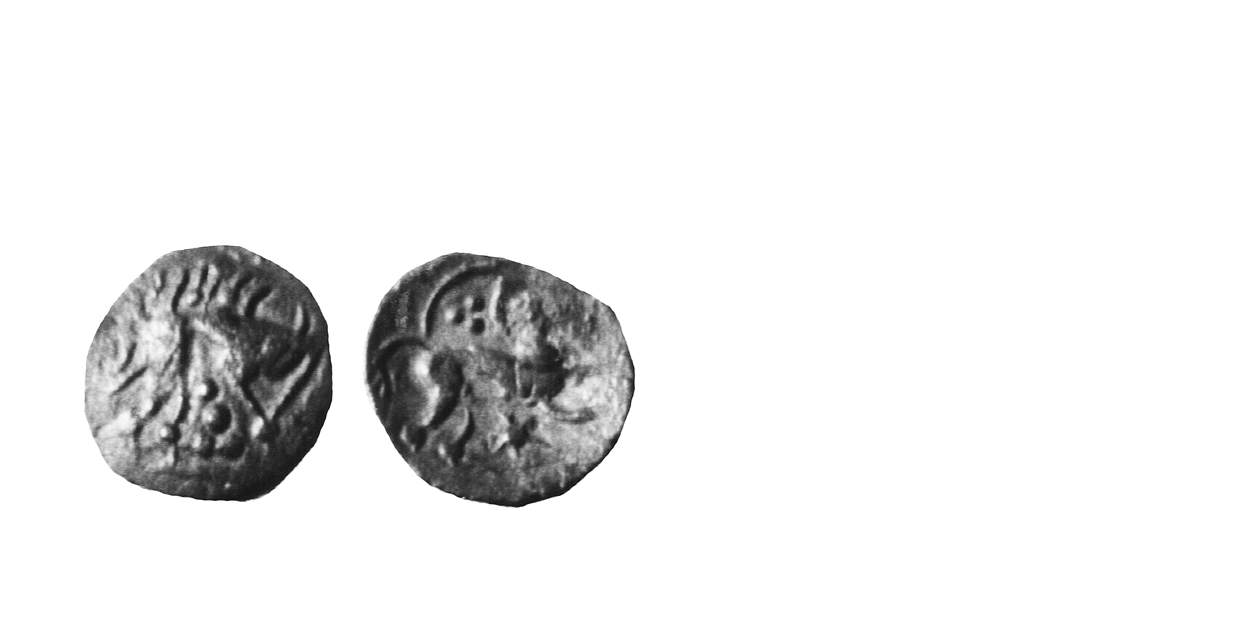
657 - 03 Boar Type
15 B.C. - 20 A.D. Rare
Silver Unit ca. 1.1 gms. 12 mm
Earliest Record: Van Arsdell, 1989
OBV: Boar right
Identifying points:
1) as 657 - 01, but pellet on boar's shoulder
REV: Celticized horse right
Identifying points:
1) as 657 - 01
CLASSIFICATION: Icenian C
NOTES:
- Many are in museums
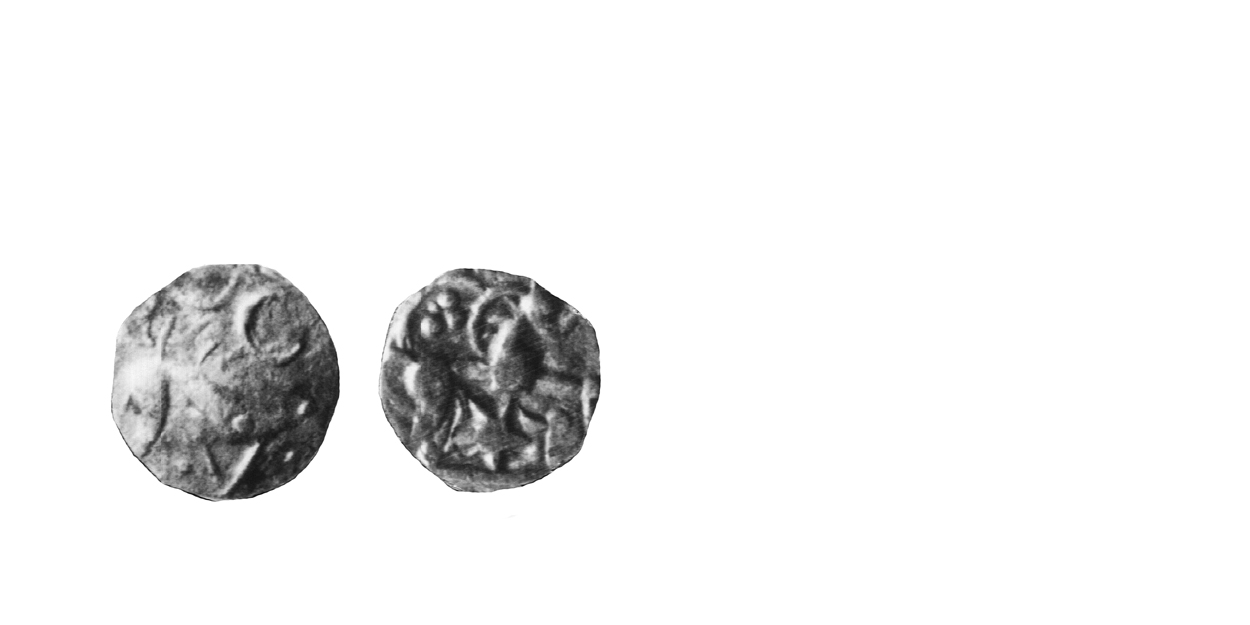
657 - 03 Boar Type
15 B.C. - 20 A.D. Rare
Silver Unit ca. 1.1 gms. 12 mm
Earliest Record: Van Arsdell, 1989
OBV: Boar right
Identifying points:
1) as 657 - 01, but pellet on boar's shoulder
REV: Celticized horse right
Identifying points:
1) as 657 - 01
CLASSIFICATION: Icenian C
NOTES:
- Many are in museums
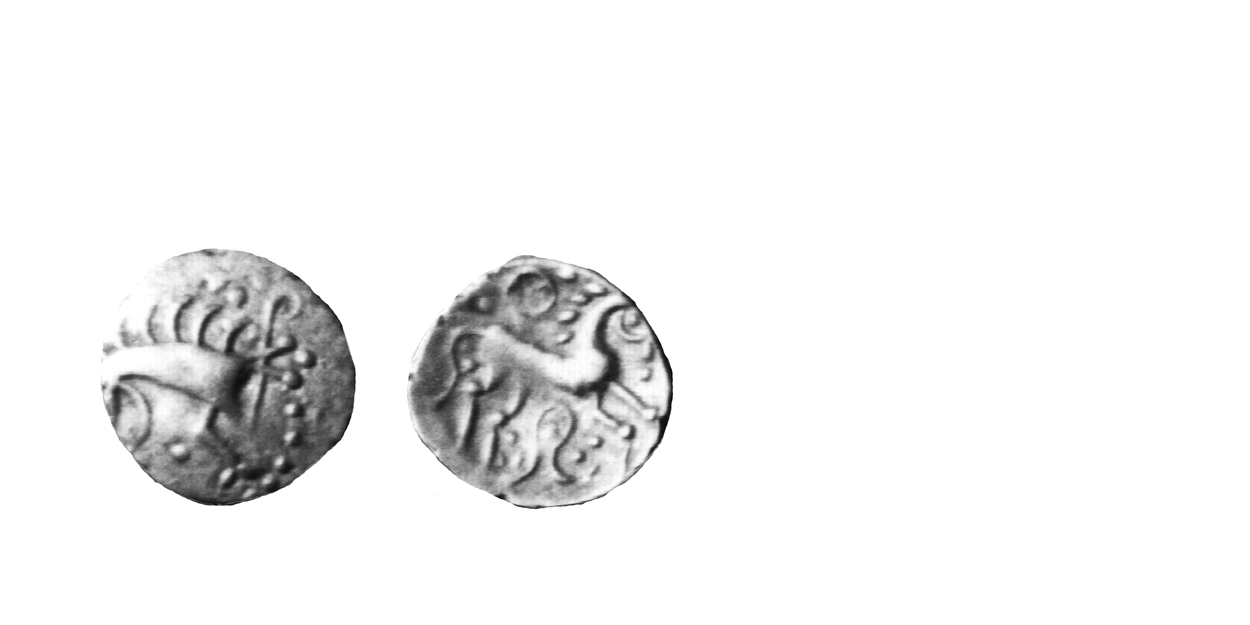
659 - 01 Boar Type
15 B.C. - 20 A.D. Common
Silver Unit ca. 1.1 gms. 14 mm
Earliest Record: Evans, 1864
OBV: Boar right
Identifying points:
1) pellets above and in front of boar
2) pellet below boar's tail
3) upper portion of boar's front leg comprised of two lines
4) no pellet on boar's shoulder
5) single pellet below boar
6) ring-and-pellet motif behind boar
REV: Celticized horse right
Identifying points:
1) three pellets and four-spoked wheel above horse
2) five pellets and a cotter-pin shaped line below horse
3) horse has eye comprised of a large pellet
CLASSIFICATION: Icenian C
NOTES:
- Many are in museums
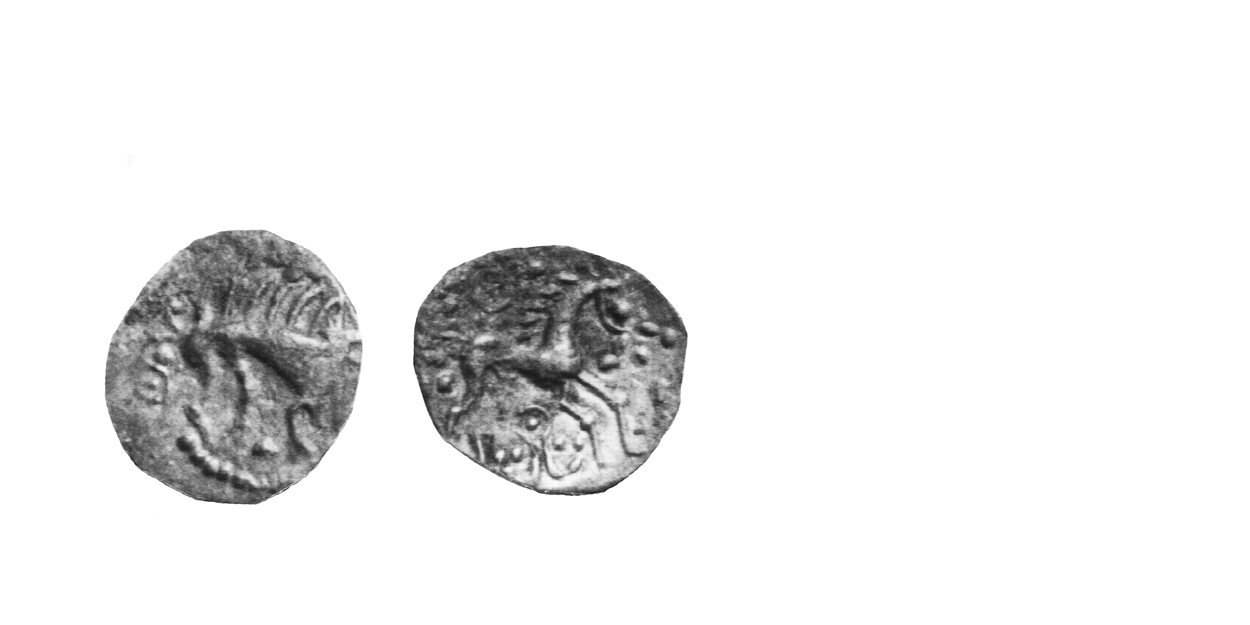
659 - 01 Boar Type
15 B.C. - 20 A.D. Common
Silver Unit ca. 1.1 gms. 14 mm
Earliest Record: Evans, 1864
OBV: Boar right
Identifying points:
1) pellets above and in front of boar
2) pellet below boar's tail
3) upper portion of boar's front leg comprised of two lines
4) no pellet on boar's shoulder
5) single pellet below boar
6) ring-and-pellet motif behind boar
REV: Celticized horse right
Identifying points:
1) three pellets and four-spoked wheel above horse
2) five pellets and a cotter-pin shaped line below horse
3) horse has eye comprised of a large pellet
CLASSIFICATION: Icenian C
NOTES:
- Many are in museums
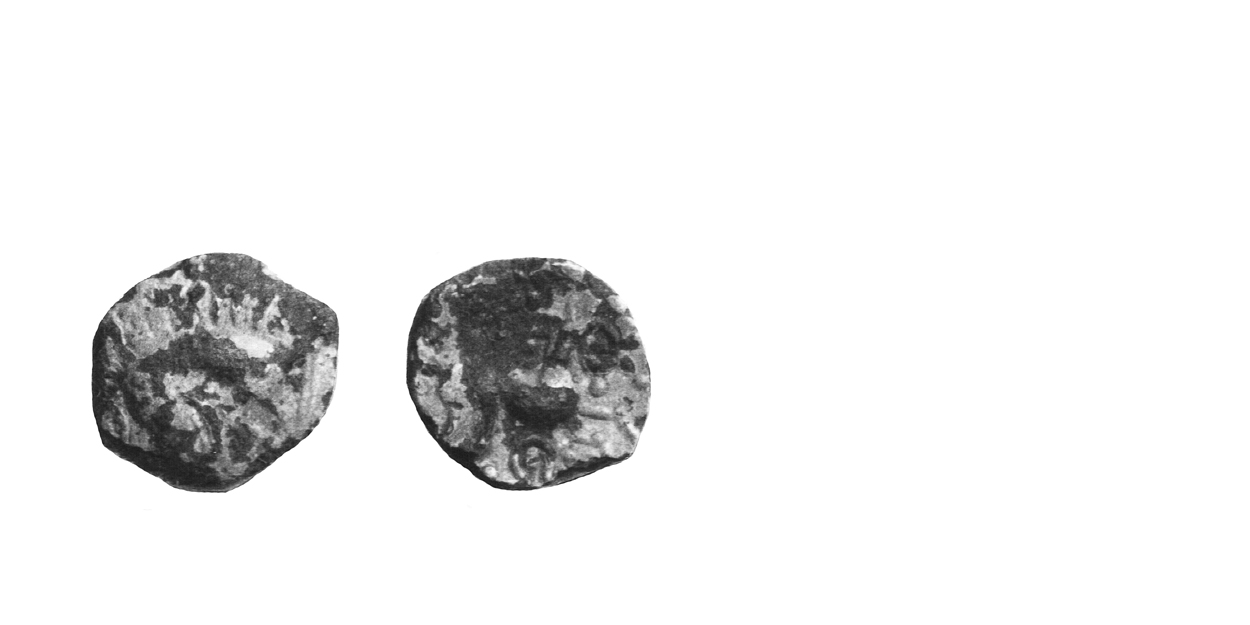
659 -02 Boar Type
Silver/Bronze Plated Unit Extremely Rare
ca. 0.9 gm 14 mm
Earliest Record: Van Arsdell, 1989
OBV: Boar right
Identifying points:
1) as 659 - 01
REV: Celticized horse right
Identifying points:
1) as 659 - 01
CLASSIFICATION: Icenian C
NOTES:
- An ancient forgery of 659 - 01, comprised of a bronze core covered with silver
- The field ornaments are the same and the style similar, but the coin is not an exact duplicate
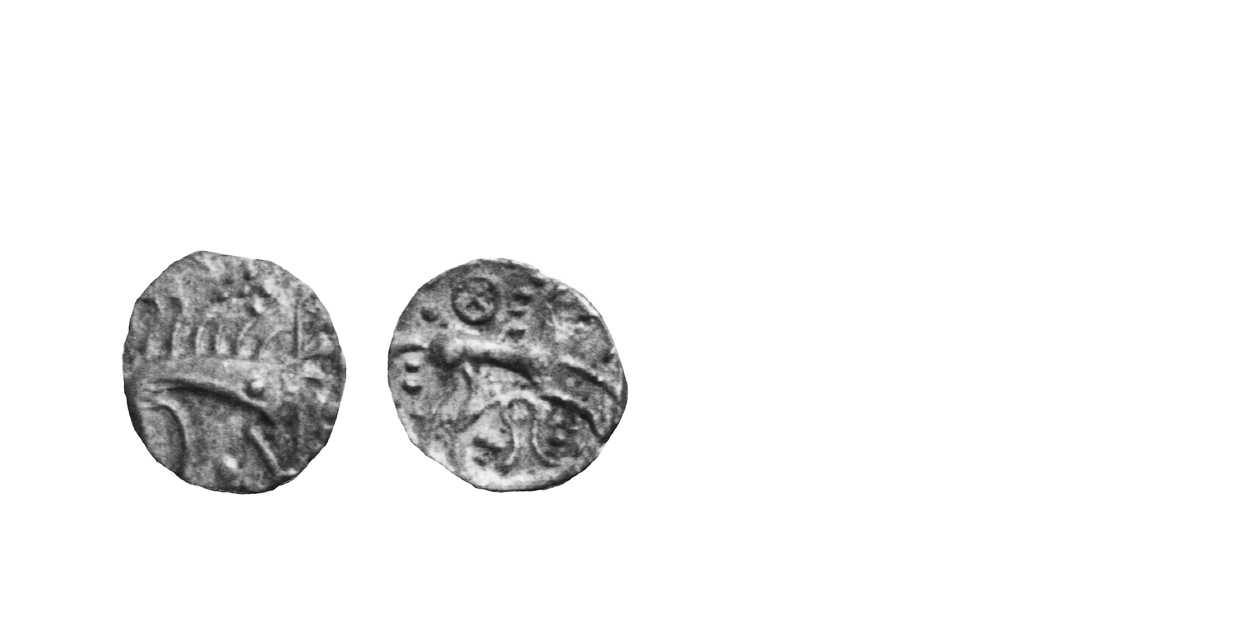
659 - 03 Boar Type
15 B.C. - 20 A.D. Common
Silver Unit 13 mm
Earliest Record: Van Arsdell, 1989
OBV: Boar right
Identifying points:
1) as 659 - 01, but pellet on boar's shoulder
REV: Celticized horse right
Identifying points:
1) as 659 - 01
CLASSIFICATION: Icenian C
NOTES:
- Most are in museums
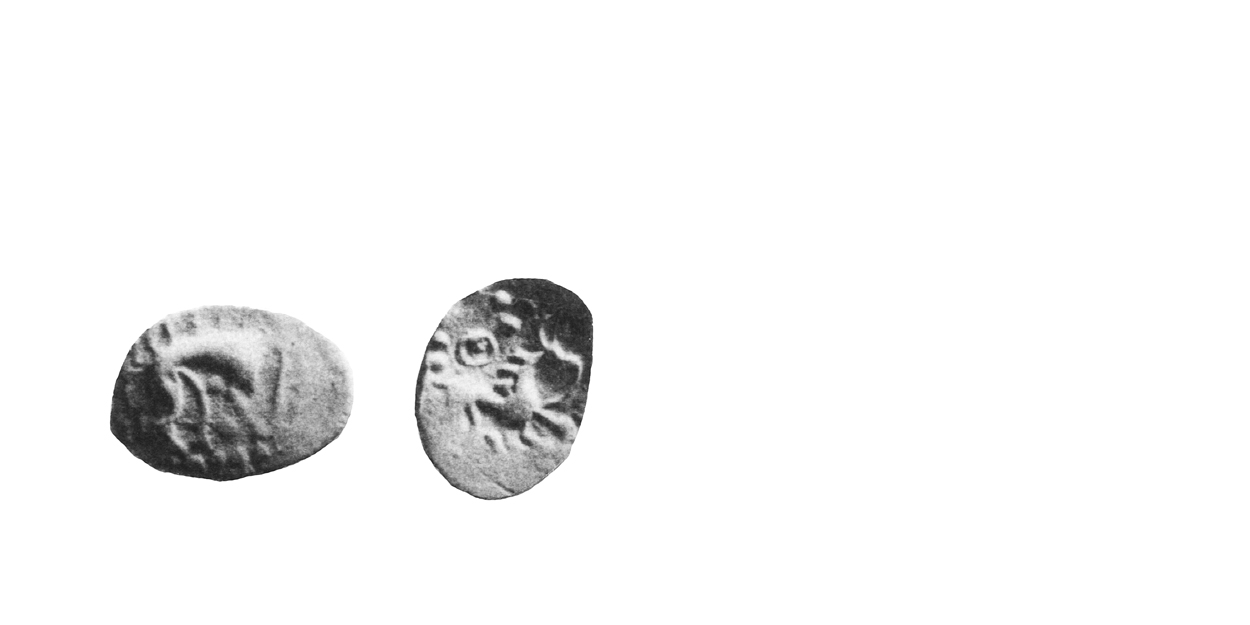
661 - 01 Boar Type
15 B.C. - 20 A.D. Scarce
Silver Fraction ca. 0.5 gm. ca. 11 mm
Earliest Record: Evans, 1864
OBV: Boar right
Identifying points:
1) two or three pellets below boar
2) upper portion of boar's front leg comprised of two lines
REV: Celticized horse right
Identifying points:
1) horse has bridle
2) ring-and-pellet motif above horse
CLASSIFICATION: Icenian C
NOTES:
- Flan may be elongated
Icenian Dynastic Coinages
At the end of the uninscribed coinages, an enigmatic coin appeared with the inscription CANI DURO. This may have been a local issue, or alternatively, the start of the dynastic issues.
The first certain dynastic issues start with the inscription ANTED, about 20 A.D. It is difficult to explain why the Iceni failed to inscribe their coins prior to this, possibly the Trinovantes/Catuvellauni exercised some influence over the tribe to prevent it. The coinage included a very small issue of gold staters and a large issue of silver units and fractions. ANTED is thought to be a personal name, or less likely, a title of a ruler.
Later, possibly around 35 A.D., coins inscribed ECEN appear. Again a very small issue of gold staters is accompanied with a large issue of silver units and fractions. ECEN is traditionally thought to be the name of the tribe, but is possibly the title or epithet of a ruler, instead.
Coins inscribed SAENV, AESV and ESV PRASTO ESICO FECIT appear at an uncertain date around the time of the ECEN coinage. Traditionally, the SUB ESVPRASTO coin was attributed to Prasutagus, but the interpretation has become much more complicated since 2000. The most recent thinking is that these three types are all somehow related.
A final group of uninscribed silver units starts sometime towards the end of the ECEN series and probably continues after the Claudian invasion. The very last of these coins are known only from the hoards of the Boudiccan Rebellion. These final types represent the coinage of Queen Boudicca, struck to finance the Icenian revolt of 61 A. D.
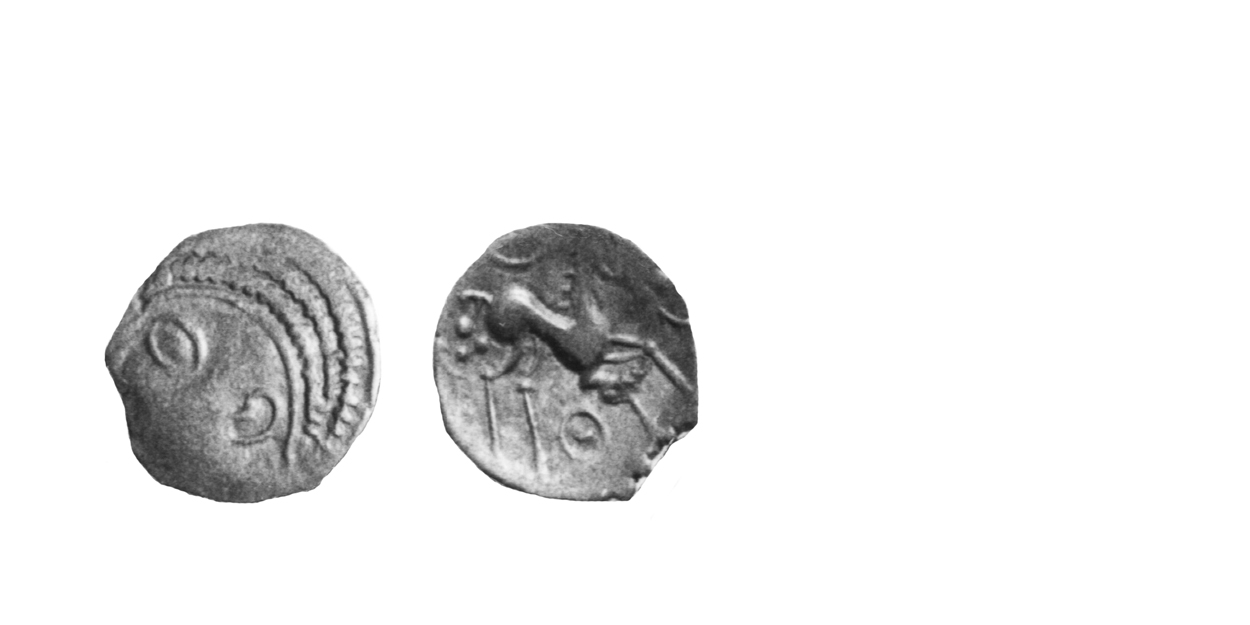
665 - 01 Celtic Head Type,
15 B.C. - 20 A.D. Scarce
Silver Unit ca. 0.9 gm. 13 mm
Earliest Record: Evans, 1864
OBV: Celticized head left
Identifying points:
1) Head much larger than flan
2) "coffee bean" for eye
3) representational ear
4) elaborately coiled hair
REV: Celticized horse right
Identifying points:
1) three pellets below tail
2) ring-and-pellet motif below horse
3) upper portion of horse's front legs comprised of two lines
CLASSIFICATION: Icenian E
NOTES:
- This coin is the earliest variety of the Celtic Head Type
- Commander Mack felt it was a link to the earlier Boar Type
- Other varieties have a less representational ear
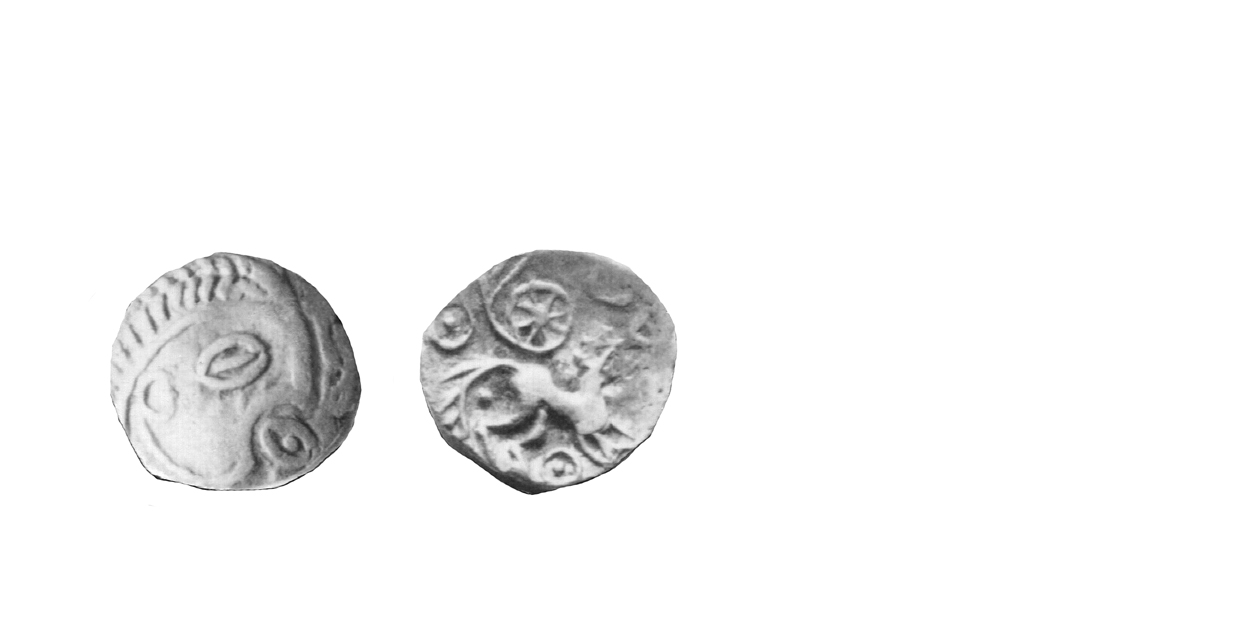
665 - 03 Celtic Head Type
15 B.C. - 20 A.D. Rare
Silver Unit 16 mm
Earliest Record: Mack, 1964
OBV: Celticized head right
Identifying points:
1) Head about the same size as the flan
2) "coffee bean" for eye
3) outline crescent for ear
4) elaborately coiled hair
REV: Celticized horse right
Identifying points:
1) eight-spoked wheel with axle above horse
2) ring-and-pellet motif above horse
3) curved lines run tangentially upwards from wheel
CLASSIFICATION: Icenian E
Notes:
- This type has been conflated with 665 - 09 by some authors – See 665 - 09
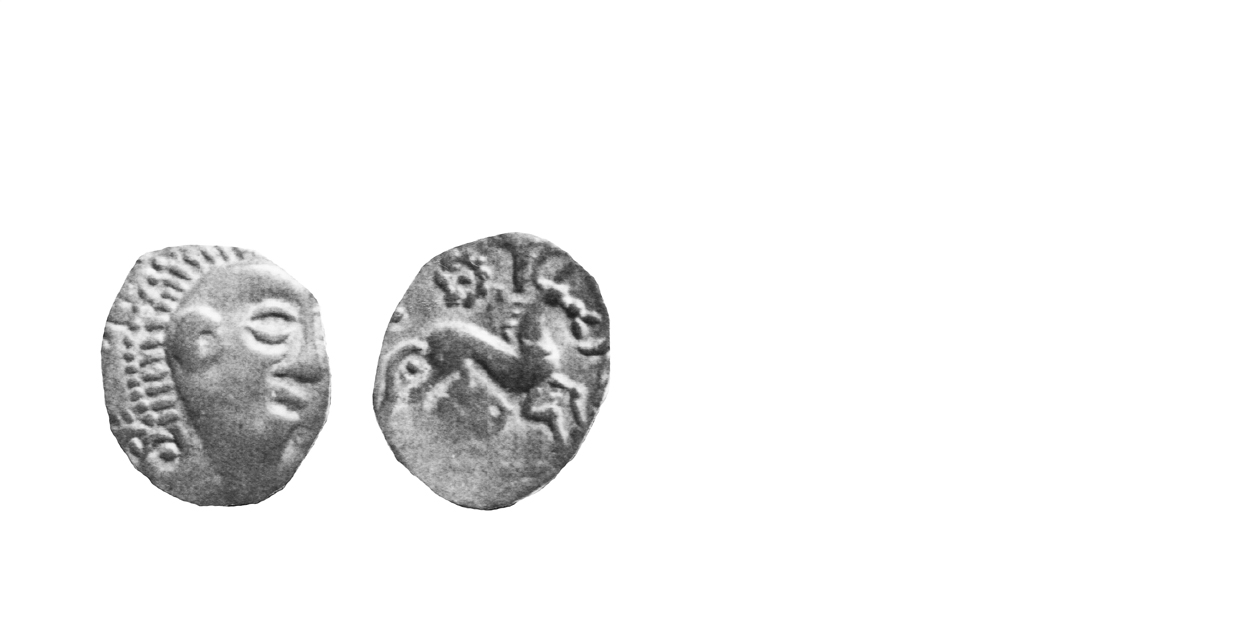
665 - 05 Celtic Head Type
15 B.C. - 20 A.D. Extremely Rare
Silver Unit 14 mm
Earliest Record: Mack, 1964
OBV: Celticized head right
Identifying points:
1) Head about the same size as the flan
2) oval shape for eye
3) outline crescent for ear
4) hair comprised of parallel lines, ending with pellets
REV: Celticized horse right
Identifying points:
1) ring of pellets above horse
2) pellet below horse's tail
3) probable ring-and-pellet motif below horse
CLASSIFICATION: Icenian E
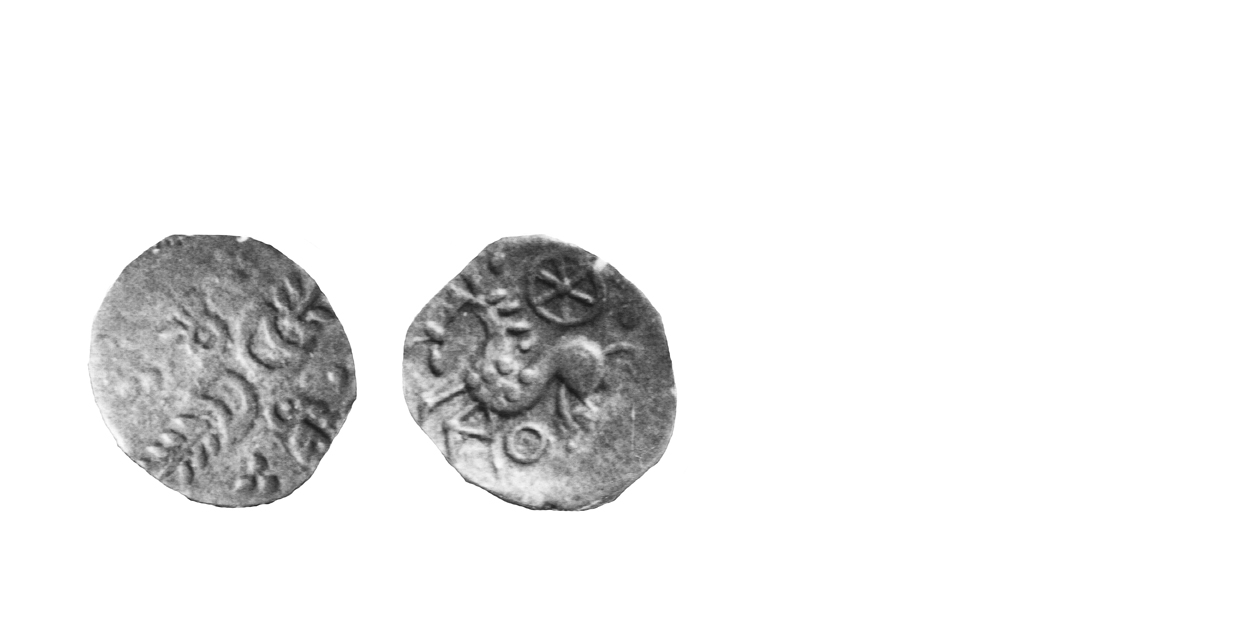
675 - 01 Crescent Type
15 B.C. - 20 A.D. Scarce
Silver Unit ca. 1.2 gms. 12 mm
Earliest Record: Evans, 1864
OBV: Crossed wreath and crescent motif
Identifying points:
1) wreath from abstracted head of Apollo transformed into a crossed pattern
2) two outline crescents, back to back in centre
3) two rings near crescents
4) pellets in angles formed by crossed wreaths
REV: Celticized horse left
Identifying points:
1) six-spoked wheel above horse
2) pellets on horse's shoulder
CLASSIFICATION: Icenian F
NOTES:
- A variant type, possibly a local issue
- Dating less certain than for other coins in this series
- Most are in museums
- John Talbot assigns this to "Mint Group C"
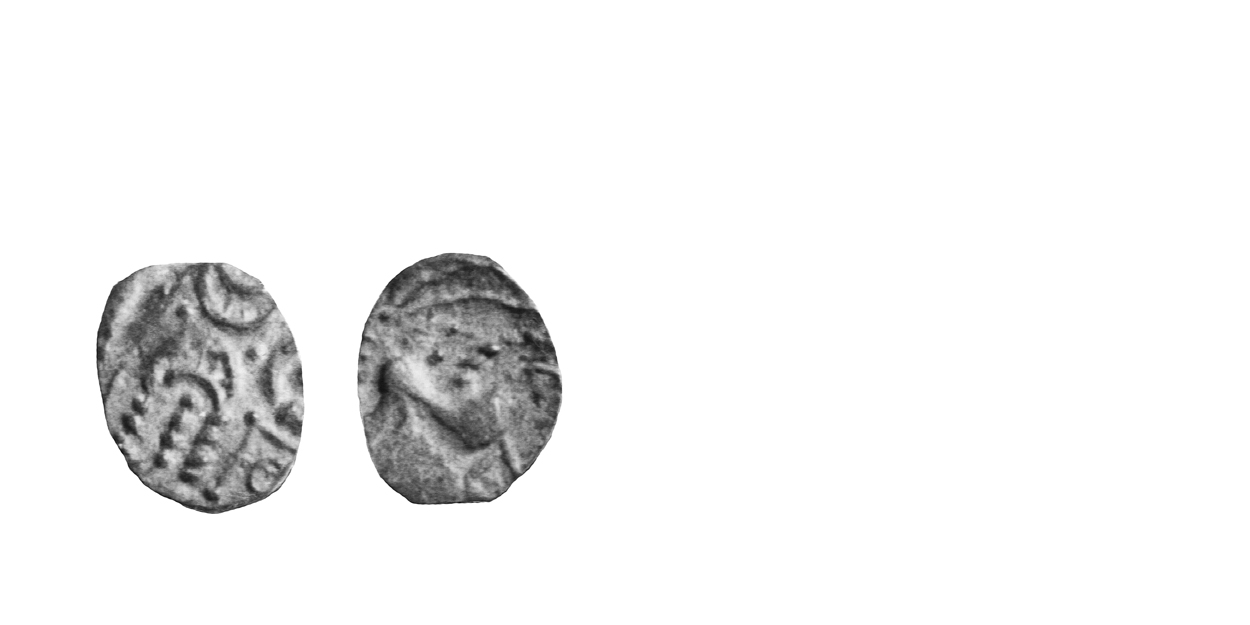
679 - 01 Crescent Type
15 B.C. - 20 A.D Scarce
Silver Unit ca. 1.2 gms. 12 mm
Earliest Record: Allen, 1960
OBV: Wreath and crescent motif
Identifying points:
1) wreath from abstracted head of Apollo transformed into rows of pellets
2) two outline crescents, back to back in centre
3) two pellets near crescents
REV: Celticized horse right
Identifying points:
1) pellets above horse
CLASSIFICATION: Icenian F
NOTES:
- A variant type, possibly a local issue
- Dating less certain than for other coins in this series
- John Talbot assigns this to "Mint Group B"
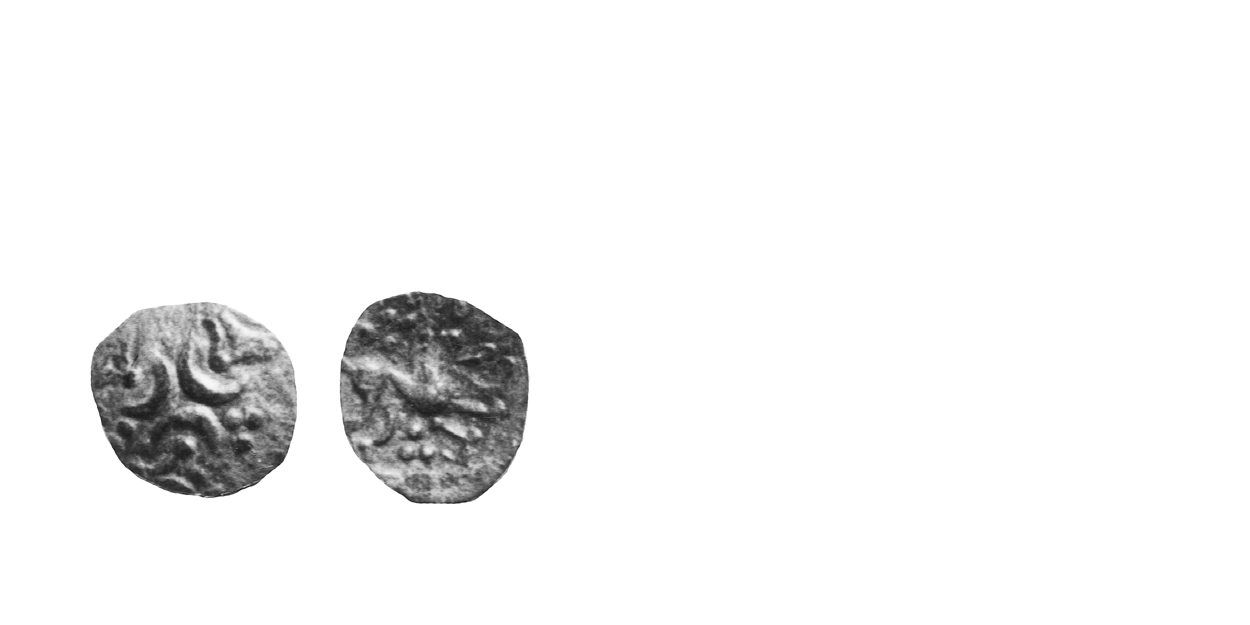
681 - 01 Crescent Type
15 B.C. - 20 A.D. Extremely Rare
Silver Fraction ca. 0.6 gm. 12 mm
Earliest Record: Evans, 1890
OBV: Crossed wreath and crescent motif
Identifying points:
1) wreath from abstracted head of Apollo transformed into a crossed pattern
2) two solid crescents, back to back in centre
3) three pellets and a solid crescent near first set of crescents
4) pellets in angles formed by crossed wreaths
REV: Celticized horse right
Identifying points:
1) pellets surround horse
CLASSIFICATION: Icenian F
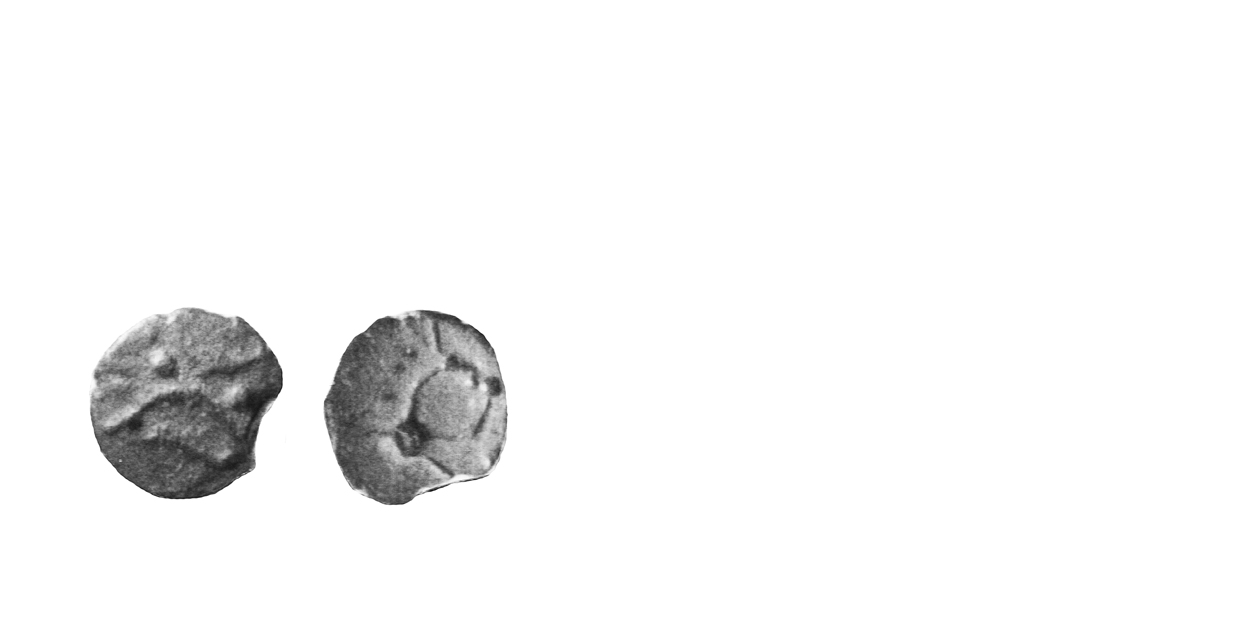
683 - 01 Crescent Type
15 B.C. - 20 A.D. Rare
Silver Fraction ca. 0.6 gm. 11 mm
Earliest Record: Mack, 1964
OBV: Wreath and crescent motif
Identifying points:
1) wreath from abstracted head of Apollo transformed into rows of pellets with thin lines attached
2) two outline crescents, back to back in centre
3) two pellets near crescents
REV: Celticized horse right Identifying points:
1) pellet in front of horse
2) horse's mane comprised of pellets with thin line attached
CLASSIFICATION: Icenian F
Notes:
- Allen, 1970 listed several uninscribed minims with similar ECEN types, but could not determine the relationship with the inscribed coins. 744 - 01 is now regarded as same type as 683 -01.
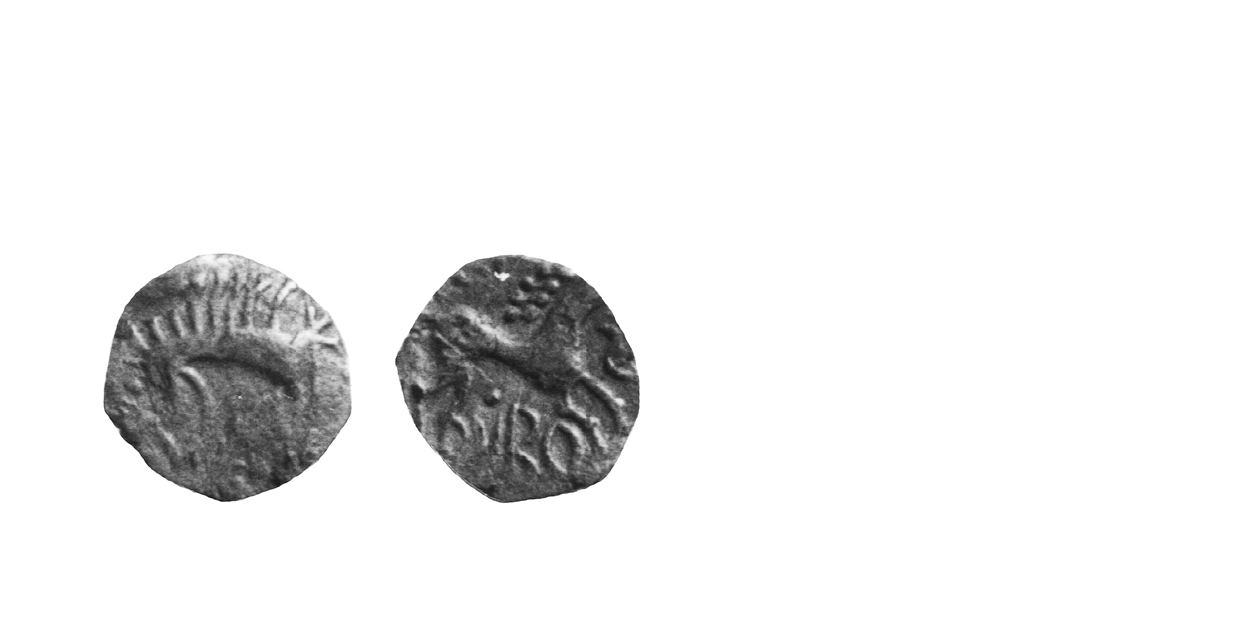
663 - 01 Boar Type CANI DVRO
15 B.C. - 30 A.D. Rare
Silver Unit 1.25 gms. 12-15 mm
Earliest Record: Stukeley, 1776
OBV: Celticized Boar right
Identifying points:
1) Ring of pellets around boar
2) Boar's tail S-shaped
3) two pellets near tail
4) "A" below boar with pellet for cross-bar, and small ring above
REV: Celticized Horse right
Identifying points:
1) CANI above horse
2) DVRO below horse
3) horse has necklace and belt
4) pellet below tail and above letter V
5) exergual line made up of a row of pellets
CLASSIFICATION: Icenian D
NOTES:
- Earliest inscribed Icenian issue
- Not necessarily a dynastic issue, possibly a local issue
- Dating less certain than other coins in this series
- Previously the inscription was read as "CAN DVRO" but newer finds now show the reading to be "CANI DVRO"
- John Talbot also cautions this may be a local issue
- Daphne Nash-Briggs suggests "CANI DVRO" could either be a personal name "Cani" with a place name "Dvro" or alternatively be a place name "Canidvro"
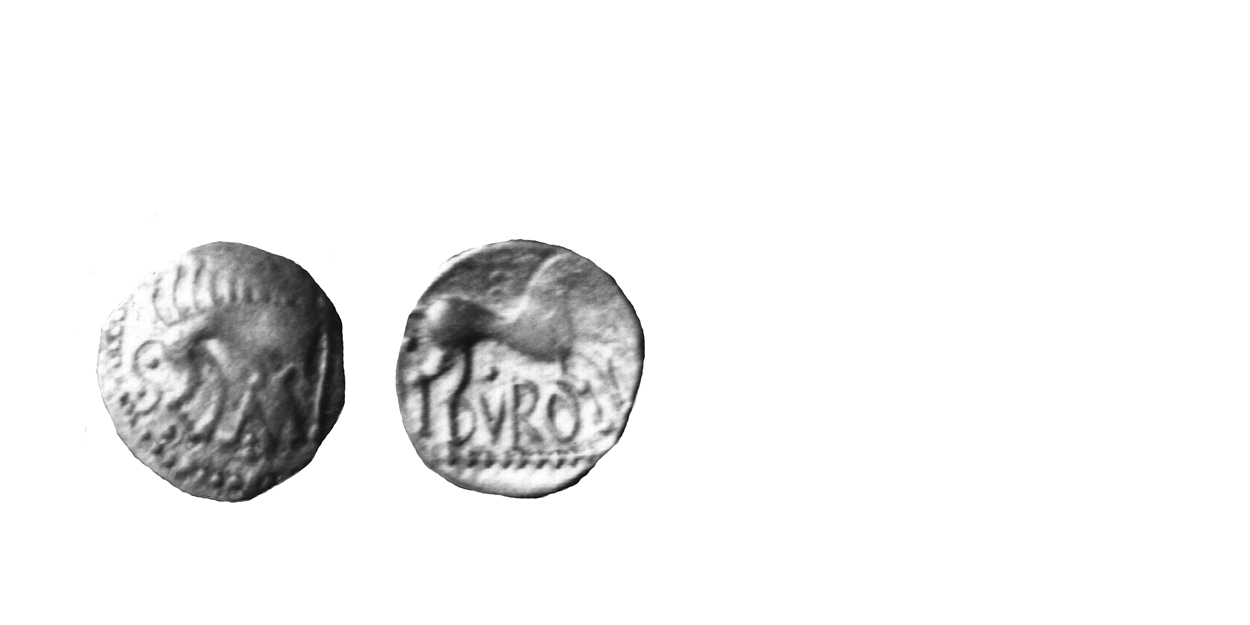
663 - 01 Boar Type CANI DVRO
15 B.C. - 30 A.D. Rare
Silver Unit 1.25 gms. 12-15 mm
Earliest Record: Stukeley, 1776
OBV: Celticized Boar right
Identifying points:
1) Ring of pellets around boar
2) Boar's tail S-shaped
3) two pellets near tail
4) "A" below boar with pellet for cross-bar, and small ring above
REV: Celticized Horse right
Identifying points:
1) CANI above horse
2) DVRO below horse
3) horse has necklace and belt
4) pellet below tail and above letter V
5) exergual line made up of a row of pellets
CLASSIFICATION: Icenian D
NOTES:
- Earliest inscribed Icenian issue
- Not necessarily a dynastic issue, possibly a local issue
- Dating less certain than other coins in this series
- Previously the inscription was read as "CAN DVRO" but newer finds now show the reading to be "CANI DVRO"
- John Talbot also cautions this may be a local issue
- Daphne Nash-Briggs suggests "CANI DVRO" could either be a personal name "Cani" with a place name "Dvro" or alternatively be a place name "Canidvro"
The Coinage of the Iceni
The Iceni occupied the area that is today Norfolk, Suffolk and parts of Cambridgeshire. Until the time of the Gallic War, the tribe seems economically isolated. Large Flan, Defaced Die and Abstract Design Type staters are not commonly found in Icenian territory, and presumably few were imported. Locally-made coins, the NORFOLK WOLF TYPE staters and BURY TYPE silver, were first produced late in the Gallic War. The earliest Icenian gold coinage comprises gold staters with the abstracted head of Apollo on the obverse and a disjointed wolf on the reverse. The heavy weight indicates the series began some time around the end of the war. After the war, the coins become quite debased and bronze cores of plated staters occur with some frequency. Later, a small coinage of SNETTISHAM TYPE coins were struck in gold and silver.
Apparently, extensive trading contacts developed during the war with the Trinovantes/Catuvellauni. A small number of Gallic War Type staters are found and uninscribed staters of the Trinovantes/Catuvellauni also appear. After the war, the coins of Addedomaros and Tasciovanus circulated. It is possible the Iceni relied on these imports instead of striking their own gold in volume.
About 20 B.C., the gold content of the Icenian coinage was restored with the introduction of the FRECKENHAM TYPE. Staters and quarters were struck lighter in weight to conform with the coinages of the other British tribes. The staters had a flower pattern or cross of pellets on the obverse and a Celticized horse on the reverse. Three major types occurred, described either as EARLIER and LATER, based on style and the progressive damage to one particular die linked with several others. Since all three types occurred in the Freckenham Hoard, it is likely they were contemporary.
After the war an extensive Icenian silver coinage was produced, which probably continued up to the time of the Boudiccan Rebellion. Silver units were produced to a standard weight of 1.25g. for nearly 100 years, a remarkable economic and technological achievement. There was a bewildering succession of types, subtypes and minor die varieties. These varieties have been systematically analyzed by John Talbot, and the arrangement is now reasonably certain. It appears that in any given period, three separate kinds of silver were being struck. Talbot suggests that the main Icenian mint either had two branch mints, or alternatively three workshops within a single mint. It is also possible that the different kinds of silver were either produced for different purposes, or perhaps at different times within a given period. Generally, the absolute chronology needs additional work. The chronology used here makes use of the work reported in John Talbot and Ian Leins's 2010 paper in The British Numismatic Journal.
The FRECKENHAM TYPE disappeared by 20 A.D. and the uninscribed silver coins were superseded by the dynastic. Very few inscribed gold coins are known. It is possible the gold coinage was minimal and the Iceni used silver coins augmented with Trinovantian/Catuvellaunian gold after 20 A.D. The Icenian dynastic period is largely one of a prolific silver coinage, beginning with the addition of an inscriptions to the CRESCENT TYPE and the introduction of the EMBLEM TYPE.
Most of the major types are listed here, but some of the minor issues need to be added. The dating of the various issues is controversial and that offered is somewhat arbitrary, based on die studies, typological sequences and analyses of coin hoards deposited around the rebellion of 61 A.D.
